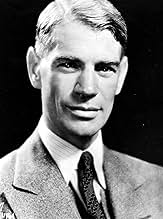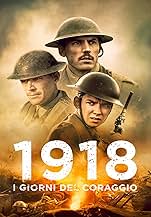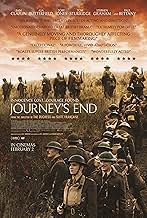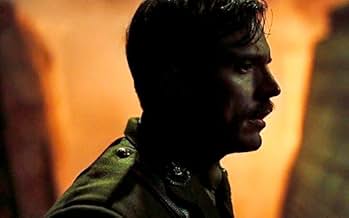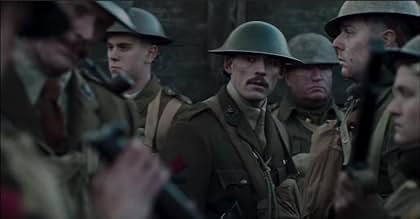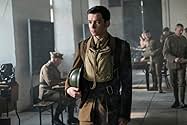NOTE IMDb
6,7/10
12 k
MA NOTE
Dans un tranché en l'Aisne en 1918, c'est une histoire d'un groupe d'officiers britanniques, menés par le jeune officier Stanhope qui perd ses facultés mentales, alors qu'ils attendent leur ... Tout lireDans un tranché en l'Aisne en 1918, c'est une histoire d'un groupe d'officiers britanniques, menés par le jeune officier Stanhope qui perd ses facultés mentales, alors qu'ils attendent leur destin.Dans un tranché en l'Aisne en 1918, c'est une histoire d'un groupe d'officiers britanniques, menés par le jeune officier Stanhope qui perd ses facultés mentales, alors qu'ils attendent leur destin.
- Réalisation
- Scénario
- Casting principal
- Récompenses
- 4 victoires et 3 nominations au total
Avis à la une
Ever watch a movie that was so good, so well done that it ceases to be theater - it seems real? That's the feeling one gets watching director Saul Dibb's "Journey's End", a masterpiece on several different levels. The actors are superb, the sets unsettlingly authentic and with a spellbinding screenplay, despite taking place mainly in a wartime trench. The ominous background score heightens the film's feeling of impending tragedy.
It is WWI in 1918, somewhere on 'The Front'. The commanding officer is Capt. Stanhope (Sam Claflin), who apparently suffers from battle fatigue as he tries to keep his men, as well as himself, from feeling the effects of the growing despair that grips his company as they await the German's massive attack which has been foretold by a captured German soldier. Director Dibb captures the emotional tone in the claustrophobic officers dugout as we learn the motivations as well as the mental aspect of each. And there is no thought, of course, of a wise retreat.
"Journey's End" is more evidence of how european filmmaking has eclipsed that of the U.S. American studios are too timid to back a film considered too daring and that would break the mold of the cookie-cutter stories emanating from its assembly line. So, those of us interested in excellence in film must forage around. My star rating is in the heading as the website no longer prints mine.
It is WWI in 1918, somewhere on 'The Front'. The commanding officer is Capt. Stanhope (Sam Claflin), who apparently suffers from battle fatigue as he tries to keep his men, as well as himself, from feeling the effects of the growing despair that grips his company as they await the German's massive attack which has been foretold by a captured German soldier. Director Dibb captures the emotional tone in the claustrophobic officers dugout as we learn the motivations as well as the mental aspect of each. And there is no thought, of course, of a wise retreat.
"Journey's End" is more evidence of how european filmmaking has eclipsed that of the U.S. American studios are too timid to back a film considered too daring and that would break the mold of the cookie-cutter stories emanating from its assembly line. So, those of us interested in excellence in film must forage around. My star rating is in the heading as the website no longer prints mine.
This is definitely one of the best war movies I have ever seen.
No Rambo actions in this one. The title really depicts what the movies is all about A Journey's End. The brutality of war. Good men die like that . In times of war orders are orders. It is sad. I wonder all this potential gone to waste . Over 60 million people died in world wars. Countries destroyed. I wonder how the world would have been liked if only ...
I recommend you see this movie with high quality video . The sound is amazing& the cinematic . The acting is superb .
If you think that war is exciting . Think again . You ought to see it. Deserves a better rating.
What a contrast to so much mediocrity and worse eg. Dunkirk. Set in the trenches in March 1918 but not really about the trenches or March 1918 at all.
Superbly cast and acted, a beautifully written reflection of a junior officer's view of the penultimate stages of WW1. Even more, this is a beautifully written reflection on the human spirit in adversity. Of course some of the senior officers are somewhat caricatured - that is what happens in real life. Of course it becomes more and more difficult with the passage of time for people to understand the mentality of empire, the public schoolboy ethos embodied by Raliegh, Maybe the same bravado and fear affects people joining violent gangs - I know not - but Raleigh is about the same age as some gang members - 18/19. Stanhope at 21/22 is a veteran of war, Uncle (Osborne - quite possibly early 30s) almost a veteran of life in their eyes.
Of course such characters have been used in films since - but this was written in 1928. It cut the new ground - others have followed.
The Roman Horace said "Dulce et decorum est pro patria mori." and it took until WW2 for Patton to say "The object of war is not to die for your country but to make the other bastard die for his." But what about sending your friends, your very best friends, your nearest and dearest to near certain death. What does that "do" to a man. Stanhope knows and through this film we can maybe glimpse that horror. What happens when there is no "cunning plan" left. Uncle knew.
Hold them off for as long as you can. In 1914, in 1918 when Journey's End is set, and again at Dunkirk ordinary men really did. No doubt there are countless other examples both before and in the last 70 years.
This film is a fitting tribute to those men.
Superbly cast and acted, a beautifully written reflection of a junior officer's view of the penultimate stages of WW1. Even more, this is a beautifully written reflection on the human spirit in adversity. Of course some of the senior officers are somewhat caricatured - that is what happens in real life. Of course it becomes more and more difficult with the passage of time for people to understand the mentality of empire, the public schoolboy ethos embodied by Raliegh, Maybe the same bravado and fear affects people joining violent gangs - I know not - but Raleigh is about the same age as some gang members - 18/19. Stanhope at 21/22 is a veteran of war, Uncle (Osborne - quite possibly early 30s) almost a veteran of life in their eyes.
Of course such characters have been used in films since - but this was written in 1928. It cut the new ground - others have followed.
The Roman Horace said "Dulce et decorum est pro patria mori." and it took until WW2 for Patton to say "The object of war is not to die for your country but to make the other bastard die for his." But what about sending your friends, your very best friends, your nearest and dearest to near certain death. What does that "do" to a man. Stanhope knows and through this film we can maybe glimpse that horror. What happens when there is no "cunning plan" left. Uncle knew.
Hold them off for as long as you can. In 1914, in 1918 when Journey's End is set, and again at Dunkirk ordinary men really did. No doubt there are countless other examples both before and in the last 70 years.
This film is a fitting tribute to those men.
"Journey's End" takes place in the trenches of the Western Front in 1918. It was originally a very successful stage play in 1928 starring Lawrence Olivier in what must have been one of his first leading roles. In 1930 a film version was produced, one of the earliest British "talking pictures", directed by James Whale and starring Colin Clive (soon thereafter both were to re-team in the memorable films, "Frankenstein" and "Bride of Frankenstein).
The above is worth pointing out because the 1930 version which is still available for viewing on Youtube, makes an interesting comparison with this current production of the same story. That is because, meticulous as this production is, it was produced a century after the events depicted in the film. To the makers of this version, this material is ancient history. To the makers of the 1930 version, it was only a dozen years ago. Indeed, James Whale, who directed the 1930 film, actually had been a British officer on the Western Front during World War I. Consequently, to him, getting the details and the atmosphere right was not a matter of researching historical records, he had only to search his own memory.
Apart from the color photography and the differences in acting styles, one big difference is that the 1930 version had a lot more humor in. While the 2017 version seems unrelentingly grim, the characters in the 1930 version exhibit a lot more of the sort of dark humor that one might expect from troops in the front lines. It is almost as though that aspect of the play did not occur to the director, or else he had simply ignored it. Either that, or perhaps that sort of humor is now considered "politically incorrect".
Nevertheless, "Journey's End" is a highly evocative depiction of the Great War, and well worth seeing in this, the centennial of the end of "The War to End ALL Wars".
The above is worth pointing out because the 1930 version which is still available for viewing on Youtube, makes an interesting comparison with this current production of the same story. That is because, meticulous as this production is, it was produced a century after the events depicted in the film. To the makers of this version, this material is ancient history. To the makers of the 1930 version, it was only a dozen years ago. Indeed, James Whale, who directed the 1930 film, actually had been a British officer on the Western Front during World War I. Consequently, to him, getting the details and the atmosphere right was not a matter of researching historical records, he had only to search his own memory.
Apart from the color photography and the differences in acting styles, one big difference is that the 1930 version had a lot more humor in. While the 2017 version seems unrelentingly grim, the characters in the 1930 version exhibit a lot more of the sort of dark humor that one might expect from troops in the front lines. It is almost as though that aspect of the play did not occur to the director, or else he had simply ignored it. Either that, or perhaps that sort of humor is now considered "politically incorrect".
Nevertheless, "Journey's End" is a highly evocative depiction of the Great War, and well worth seeing in this, the centennial of the end of "The War to End ALL Wars".
"Journey's End" makes for a claustrophobic and tense movie experience. It's quite clearly a film adaptation of a stage play, but it's a surprise (to me at least) that the stage play - penned by R.C. Sherriff - dates back to 1928 and was first performed in London by a young Laurence Olivier.
You might say "A filmed stage play? Hm... I'm not sure about that". But actually, it works really well, adding brilliantly to the claustrophobic nature of the piece but - more importantly - largely eschewing "action scenes" to focus in on the dramatic relationships between the officers in their dugout and the men in the trenches above.
The plot is a simple one. Set in the spring of 1918 (arguably, the movie might have been even more powerful had its release been delayed by about 6 weeks), Captain Stanhope (Sam Claflin, "Me Before You", "Their Finest") leads a company of men marching into position in a trench near Saint-Quentin, Aisne for a six-day tour of duty. Given they are one of 1,800 such companies on the Western Front, it's unfortunately their bad luck that the German's "spring offensive" is forecast to happen imminently. As Stanhope's CO (the excellent Robert Glennister, "Live by Night", TV's "Hustle") makes clear, and as the film's title might also suggest, this is forecast to be a one-way trip.
With immaculate timing, squeaky-keen young recruit Lieutenant Raleigh (Asa Butterfield, "Hugo") uses his brass-connections to join the company, since he knows Stanhope from his schooldays. Indeed, Stanhope is his sister's beau. But Raleigh soon discovers that Stanhope is no longer the 'affable chap' he was....
Butterfield is marvelously cast as the perky new recruit, all wide-eyed and eager on arrival but completely ill-equipped for what he is to see and experience in a confined society being stretched beyond breaking point. Claflin as well is superb, and must have spent hours in front of a mirror trying to perfect his haunted expression. The range of emotions he delivers through those eyes is just extraordinary. Finally rounding out the star-turns of the officers are Paul Bettany ("Avengers: Age of Ultron") as the avuncular Osborne and Tom Sturridge ("Far From The Madding Crowd") as the shell-shocked and useless Hibbert.
Those of you familiar with the splendid "Black Adder Goes Forth" will know the comic role played by Tony Robinson as Baldrick with his strange culinary concoctions. In this film Toby Jones ("Atomic Blonde", "Dad's Army") fills that role and similarly has some comic lines to add - just a touch of - much needed light-relief to the tension.
The film has a necessarily melancholic feel, but (for me) it's rather over-egged by the sonorous cello score by Natalie Holt and Hildur Gudnadóttir. (Again, reflecting our different tastes, I'll point out that my wife found the music fitting and not as annoying and intrusive as I did).
Director Sean Dibb (Suite Française) has here delivered a tense and very well-executed movie that ably demonstrates the British "stiff upper lip" in public - and the weak whiskey-soaked psychosis in private - of men under the most unbearable stress imaginable. Recommended... but go expecting something that's more drama than World War One 'action'.
(For the full graphical review, please visit bob-the-movie-man.com. Thanks.)
You might say "A filmed stage play? Hm... I'm not sure about that". But actually, it works really well, adding brilliantly to the claustrophobic nature of the piece but - more importantly - largely eschewing "action scenes" to focus in on the dramatic relationships between the officers in their dugout and the men in the trenches above.
The plot is a simple one. Set in the spring of 1918 (arguably, the movie might have been even more powerful had its release been delayed by about 6 weeks), Captain Stanhope (Sam Claflin, "Me Before You", "Their Finest") leads a company of men marching into position in a trench near Saint-Quentin, Aisne for a six-day tour of duty. Given they are one of 1,800 such companies on the Western Front, it's unfortunately their bad luck that the German's "spring offensive" is forecast to happen imminently. As Stanhope's CO (the excellent Robert Glennister, "Live by Night", TV's "Hustle") makes clear, and as the film's title might also suggest, this is forecast to be a one-way trip.
With immaculate timing, squeaky-keen young recruit Lieutenant Raleigh (Asa Butterfield, "Hugo") uses his brass-connections to join the company, since he knows Stanhope from his schooldays. Indeed, Stanhope is his sister's beau. But Raleigh soon discovers that Stanhope is no longer the 'affable chap' he was....
Butterfield is marvelously cast as the perky new recruit, all wide-eyed and eager on arrival but completely ill-equipped for what he is to see and experience in a confined society being stretched beyond breaking point. Claflin as well is superb, and must have spent hours in front of a mirror trying to perfect his haunted expression. The range of emotions he delivers through those eyes is just extraordinary. Finally rounding out the star-turns of the officers are Paul Bettany ("Avengers: Age of Ultron") as the avuncular Osborne and Tom Sturridge ("Far From The Madding Crowd") as the shell-shocked and useless Hibbert.
Those of you familiar with the splendid "Black Adder Goes Forth" will know the comic role played by Tony Robinson as Baldrick with his strange culinary concoctions. In this film Toby Jones ("Atomic Blonde", "Dad's Army") fills that role and similarly has some comic lines to add - just a touch of - much needed light-relief to the tension.
The film has a necessarily melancholic feel, but (for me) it's rather over-egged by the sonorous cello score by Natalie Holt and Hildur Gudnadóttir. (Again, reflecting our different tastes, I'll point out that my wife found the music fitting and not as annoying and intrusive as I did).
Director Sean Dibb (Suite Française) has here delivered a tense and very well-executed movie that ably demonstrates the British "stiff upper lip" in public - and the weak whiskey-soaked psychosis in private - of men under the most unbearable stress imaginable. Recommended... but go expecting something that's more drama than World War One 'action'.
(For the full graphical review, please visit bob-the-movie-man.com. Thanks.)
Le saviez-vous
- AnecdotesPlaywright R.C. Sherriff had seen first-hand the effect of years of war on his friends and knew the fear and terror of waiting for an impending attack, waiting for his journey's end. The characters in the play are a reflection of the men Sherriff had served with in the 9th Battalion of the East Surrey Regiment.
- GaffesA common misconception is the myth about having your chinstrap unbuckled. It is mainly an American thing that was spread in WW2. Fact is, if the concussion was strong enough to hurt your neck or face because your chinstrap was buckled, the force of the same concussion would more than likely kill you. Having your strap undone just meant you would spend a lot of time holding your helmet on while moving fast.
- Citations
Lieutenant Osborne: Every little noise up there, makes me feel sick.
- ConnexionsFeatured in Projector: Journey's End (2018)
- Bandes originalesElevation
Written and performed by Hildur Guðnadóttir
Meilleurs choix
Connectez-vous pour évaluer et suivre la liste de favoris afin de recevoir des recommandations personnalisées
- How long is Journey's End?Alimenté par Alexa
Détails
- Date de sortie
- Pays d’origine
- Langues
- Aussi connu sous le nom de
- Journey's End
- Lieux de tournage
- Sociétés de production
- Voir plus de crédits d'entreprise sur IMDbPro
Box-office
- Montant brut aux États-Unis et au Canada
- 161 796 $US
- Week-end de sortie aux États-Unis et au Canada
- 11 798 $US
- 18 mars 2018
- Montant brut mondial
- 970 809 $US
- Durée1 heure 47 minutes
- Couleur
- Rapport de forme
- 1.85 : 1
Contribuer à cette page
Suggérer une modification ou ajouter du contenu manquant

Lacune principale
By what name was Men of Honor (2017) officially released in India in Hindi?
Répondre




